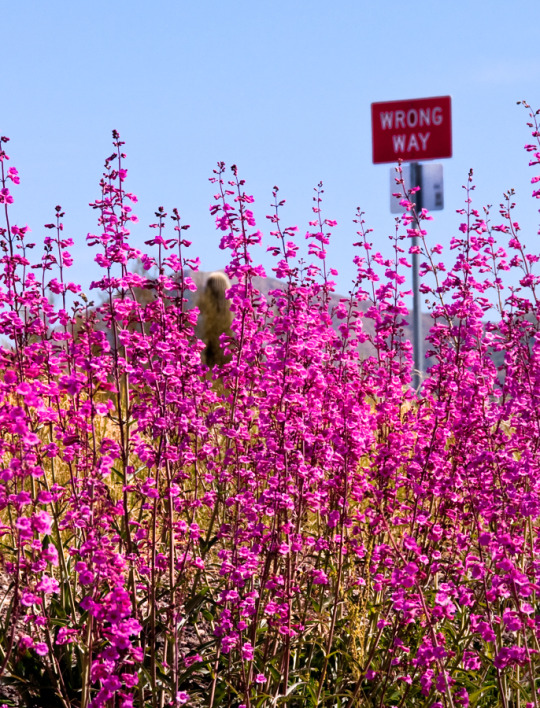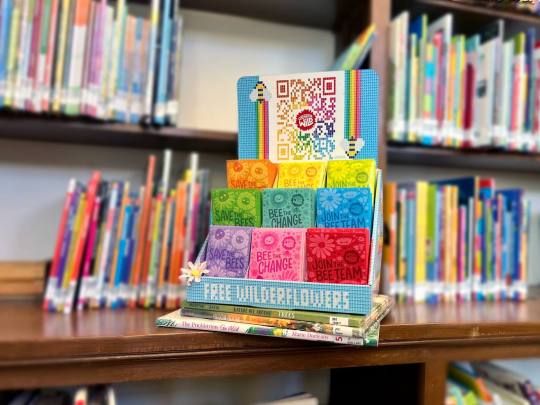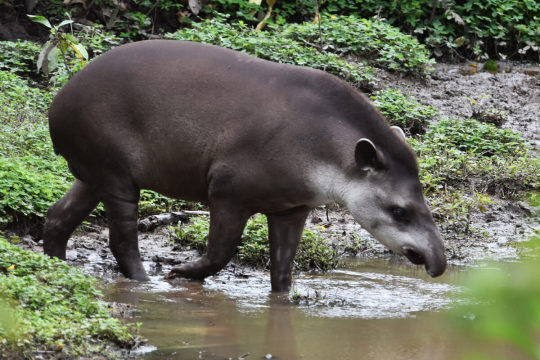#pollinator gardens
Explore tagged Tumblr posts
Text
Excerpt from this story from Revelator:
Every June, cities around the globe celebrate Pollinator Week, an international event to raise awareness about the important roles that birds, bats, bees, butterflies, beetles, and other small mammals serve in pollinating our food systems and landscapes. These crucial species are declining worldwide, with many on the brink of extinction.
Cities have responded to this crisis with a variety of urban initiatives designed to foster pollinator habitats and in the process transform once-stark cement landscapes — as well as pocket parks, curb strips, and highway dividers — into lush, welcoming areas for pollinators and humans alike.
In Washington, D.C., ambitious pollinator projects are abundant on rooftops of public, office, and private spaces, ranging from the renovated D.C. Public Library’s main branch to National Public Radio’s headquarters, which hosts an apiary. Throughout the District of Columbia, municipal code requires buildings to maintain the tree boxes and curb strips outside their properties. This often leads to creative landscaping on the smallest of scales.
It’s not just businesses. Parks and other public spaces also play an important role. For example, Fargo, North Dakota’s Urban Pollinator Plots Project aims to establish more than 50 acres of high diversity, forb-rich, native prairie plantings in urban parklands.
“I think some of the bigger challenges are just simply the establishment of the prairie,” says Sam DeMarais, a park forester in the Fargo Park District, who oversees the program. “It’s a skill set and a knowledge base that really takes a keen eye and some diligence on doing it properly. Everyone thinks you can just plant the prairie and let it go, but that’s not really the case.”
Fargo’s and Washington, D.C.’s programs are each over 10 years old, and time has brought knowledge of what works and doesn’t, and the ability to adapt. But less-established initiatives across the country could provide even more clues. A new project at the Port of Vancouver, in Washington state, aims to add a small native plant and flower pollinator garden in the port’s mitigation bank in the Lower Columbia River watershed. It could serve as a case study in introducing pollinators into industrial areas. In Michigan, the nonprofit organization Detroit Hives showcases how to transform vacant lots into pollinator-friendly habitat, a program that recently contributed to Detroit joining the Bee City USA program. Researchers in Puerto Rico are examining the relationships between animal and plant resources in urban areas on the island, and conducting interviews to learn more about public perspectives on plants and wildlife.
But why stop at the city level? Pollinator programs around the world can look to Ireland, where the entire island, north and south, has implemented the All-Ireland Pollinator Plan, a program that brings together community groups, local authorities, councils, businesses, farmers, and others to create a pollinator-friendly landscape.
43 notes
·
View notes
Text
Unveiling the Desert's Charm: Growing Penstemons and Wildflowers in Queen Creek, Arizona
Transforming Arid Landscapes into Blossoming Gardens In the heart of the Sonoran Desert, amidst the dry, rugged landscape of Queen Creek, Arizona, lies the potential for a blooming oasis. The key to this transformation? A brilliant array of penstemons and native wildflowers. This article will guide you through selecting the best penstemons for the low desert and companion wildflowers to create a…

View On WordPress
#Desert Beardtongue#desert gardening#Desert Landscaping#Drought-Tolerant Plants#Eco-Friendly Gardening#Firecracker Penstemon#Garden Design#Growing Wildflowers#Hummingbird-Friendly Gardening#Native Plants#Penstemon Cultivation#Penstemon eatonii#Penstemon parryi#Penstemon pseudospectabilis#Pollinator Gardens#Queen Creek Arizona#Seed Germination#Sustainable Gardening#Xeriscaping
5 notes
·
View notes
Text
Remember choose native plants when you can for your pollinator gardens. It helps your local cryptids.

15K notes
·
View notes
Text
Some of you may have heard about Monarch butterflies being added to the Threatened species list in the US and be planning to immediately rush out in spring and buy all the milkweed you can manage to do your part and help the species.
And that's fantastic!! Starting a pollinator garden and/or encouraging people and businesses around you to do the same is an excellent way to help not just Monarchs but many other threatened and at-risk pollinator species!
However.
Please please PLEASE do not obtain Tropical Milkweed for this purpose!
Tropical milkweed (Asclepias curassavica)--also commonly known as bloodflower, Mexican butterflyweed, and scarlet milkweed--will likely be the first species of milkweed you find for sale at most nurseries. It'll be fairly cheap, too, and it grows and propagates so easily you'll just want to grab it! But do not do that!
Tropical milkweed can cause a host of issues that can ultimately harm the butterflies you're trying to help, such as--
Harboring a protozoan parasite called OE (which has been linked to lower migration success, reductions in body mass, lifespan, mating success, and flight ability) for long periods of time
Remaining alive for longer periods, encouraging breeding during migration time/overwintering time as well as keeping monarchs in an area until a hard freeze wherein which they die
Actually becoming toxic to monarch caterpillars when exposed to warmer temperatures associated with climate change
However--do not be discouraged!! There are over 100 species of milkweed native to the United States, and plenty of resources on which are native to your state specifically! From there, you can find the nurseries dedicated to selling native milkweeds, or buy/trade for/collect seeds to grow them yourself!!
The world of native milkweeds is vast and enchanting, and I'm sure you'll soon find a favorite species native to your area that suits your growing space! There's tons of amazing options--whether you choose the beautiful pink vanilla-smelling swamp milkweed, the sophisticated redring milkweed, the elusive purple milkweed, the alluring green antelopehorn milkweed, or the charming heartleaf milkweed, or even something I didn't list!
And there's tons of resources and lots of people willing to help you on your native milkweed journey! Like me! Feel free to shoot me an ask if you have any questions!
Just. PLEASE. Leave the tropical milkweed alone. Stay away.
TLDR: Start a pollinator garden to help the monarchs! Just don't plant tropical milkweed. There's hundreds of other milkweeds to grow instead!
#milkweed#monarchs#monarch butterfly#pollinator garden#pollinator gardening#outdoor gardening#gardening#flower gardening#out of queue#ani rambles
19K notes
·
View notes
Text
Mexico City; Mexico.

With almost 22 million inhabitants, Mexico City is the country’s most populous city. One of its most significant urban challenges is the city’s poor air quality, which the city government aims to tackle through the “Plan Verde” (Green Plan). By participating in the “Trees in Cities Challenge”, Mexico City aims to preserve and enhance biodiversity, strengthen the environmental awareness of its residents and enhance ecosystem services in its urban area. By mid-2021, the city implemented 98% of its pledge to plant 8 million new trees and shrubs, along with other activities, including the creation of 450 pollinator gardens and boosting the plant production of in its nurseries.
#mexico#cities#mexico city#trees in cities#urban trees#trees#pollinator gardens#native species#tree planting pledges#urban october
1 note
·
View note
Photo

Landscape in New York Photo of a mid-sized traditional partial sun front yard stone garden path.
#natural stone#tiered gardens#tennessee orchard stone#banas stone#pollinator gardens#cottage garden#south bay quartzite stone
0 notes
Photo

Flower Bed Landscape This is an illustration of a sizable, drough-tolerant backyard flower bed in a farmhouse.
#pollinator gardens#design build#pollinator garden#design elements#flowering shrubs#mass planting#butterfly bush
0 notes
Text


margarida.sa.maia
#meadows#wildflowers#gardens#pollinators#nature#ecologicalgardening#biodiversity#wildlife friendly gardening#rewilding#ornamental grasses#curators on tumblr
2K notes
·
View notes
Text
World got you down?

Feeling overwhelmed?

Let’s plant some goddamn native wildflowers.

#I can and will feed pollinators and have a nice time in the process#This is my vow#garden time#(not all of these are natives I did save some sweet peas for scent because I’m a sucker)#but there’s a great mix from the local high school’s native nursery that I’ll be adding#and a couple milkweed starts#don’t let the bastards get you down
270 notes
·
View notes
Text
"Next Monday [6/17/24] is the start of National Pollinator Awareness Week, and one Colorado advocacy group is hosting a flower planting drive to rewild Colorado’s meadows, gardens, and just maybe, its children too.
Created by constitutional amendment in 1992, Great Outdoors Colorado (GOCO) is a state-funded independent board that invests a portion of Colorado Lottery proceeds to help preserve and enhance the state’s parks, trails, wildlife, rivers, and open spaces.
This year, GOCO’s offshoot Generation Wild is distributing over 100,000 free packets of wildflower seeds to collection points at museums, Denver Parks and Rec. offices, and libraries all over the state to encourage kids and families to plant the seeds in their backyards.
The Save the Bees! initiative aims to make the state more beautiful, more ecologically diverse, and more friendly to pollinators.
According to a new report from the Colorado Department of Natural Resources, 20% of Colorado’s bumblebees are now at risk of extinction. Even in a small area like a backyard, planting wildflowers can make a positive impact on the local ecosystem and provide native bees with a healthy place to live.
“The Western Bumblebee population has declined in Colorado by 72%, and we’re calling on kids across Colorado to ‘bee’ the change,” said GOCO Executive Director Jackie Miller.

Named after Generation Wild’s official mascot “Wilder,” the Wilderflower Seed Mix was developed in partnership with Applewood Seed Co. and packets are now available for pickup at designated partner sites including more than 80 Little Free Library boxes.
By distributing 100,000 Wilderflower packets, Generation Wild is providing more than 56 million seeds for planting in every nook and cranny of the state. All seeds are regionally-native to Colorado, which is important for sustaining the living landscape of bees, birds, and other animals.
Additionally, by using flower species adapted to the Mile High climate, landscapers and gardeners need to use less water than if they were tending non-native plants.
“Applewood Seed Co. was excited to jump in and help Generation Wild identify a seed mix that is native to the Colorado region and the American West, containing a diversity of flower species to attract and support Colorado’s pollinator populations,” stated Norm Poppe, CEO of Applewood Seed Co. “We hope efforts like this continue to educate the public on pollinator conservation and the need to protect our native bees and butterflies.”
Concluding her statement Miller firmly stated that children grow up better outside, and if you or a parent you know agree with her, all the information on how to participate in Save the Bees! can be found here on their website, including a map showing all the local pickup points for the Wilderflower Seed Packets."
-via Good News Network, June 13, 2024
#wildflowers#wild flowers#colorado#bees#native bees#entomology#insects#save the bees#pollinators#bumblebees#bumble bee#i love bees#biodiversity#native plants#urban gardening#gardening#ecology#conservation#endangered species#wildlife conservation#enviromentalism#good news#hope#hope posting#solarpunk#denver#boulder colorado#colorado springs#libraries#public libraries
484 notes
·
View notes
Text

Plant a Bee-friendly (and butterfly friendly) garden!
See higher quality image and find out more:
PollinatorGardenBrochure.pdf (sierraclub.org)
#gardening#gardens#plants#pollinators#wildlifer#home#home and garden#conservation#environment#nature#animals#bees#butterflies#insects
485 notes
·
View notes
Text
If you're in the U.S. and want to support local plants and pollinators, I hope you've heard of the Xerces Society. Weird name, but super cool resource for gardening for insect pollinators (and they work for other invertebrate species, too)
They've got regional native plant lists:
They've also got super helpful things in their resources section, including Washington's plan for helping bumble bees:
Another really cool resource is the National Wildlife Federation's list of key stone plant species by ecoregion:
3K notes
·
View notes
Text
there is a special place in hell for cat owners who allow their cats to free-roam a residential neighborhood because it's ~natural~.
The amount of devastation and heartbreak I have seen from loved ones whose cats accidentally got out makes me like twice as mad too because I cannot. I cannot fathom the cruelty and selfishness required to ignore what we know to be best practice for cat husbandry because your feefees get uncomfies when people tell you it's animal abuse to wilfully, knowingly cut your cat's expected lifespan from 15-20 years to 2-3.
KEEP. YOUR. FUCKING. CATS. INSIDE.
#this does not apply to people who are doing their best to care for feral colonies while providing TNR and other essential healthcare#it also does not apply to people who are trying to keep their cats indoors#it's the people who have four or five outdoor cats and an ostentatious tesla and a ~wild pollinator~ sign in their garden#guess what sweetie fluffy does more damage to wild pollinators than twenty grass lawns#the performative environmentalism paired with blasé attitudes towards the welfare of animals in their care makes me fucking seethe
326 notes
·
View notes
Text
Dandelion News - November 15-21
Like these weekly compilations? Tip me at $kaybarr1735 or check out my Dandelion Doodles! (sorry it's slightly late, the links didn't wanna work and I couldn't figure it out all day)
1. Wyoming's abortion ban has been overturned, including its ban on abortion medication

“Wyoming is the second state to have its near-total abortion ban overturned this month[…. Seven other states] also approved amendments protecting the right to an abortion. A lawsuit seeking to challenge the [FDA]’s approval of abortion medication recently failed when the Supreme Court refused to hear it[….]”
2. Patches of wildflowers in cities can be just as good for insects as natural meadows – study

“This study confirmed that small areas of urban wildflowers have a high concentration of pollinating insects, and are as valuable to many pollinators as larger areas of natural meadow that you would typically find rurally.”
3. Paris could offer new parents anti-pollution baby 'gift bags' to combat 'forever chemicals'

“The bag includes a stainless steel baby cup, a wooden toy, reusable cotton wipes, and non-toxic cleaning supplies as part of a "green prescription". […] The city will also have 44 centres for protecting mothers and infants that will be without any pollutants[….]”
4. Indigenous guardians embark on a sacred pact to protect the lowland tapir in Colombia

“The tapir is now the focus of an Indigenous-led conservation project[… A proposed “biocultural corridor”] will protect not only the populations and movements of wildlife such as tapirs, but also the cultural traditions and spirituality of the Inga and other neighboring Indigenous peoples[….]”
5. Denmark will plant 1 billion trees and convert 10% of farmland into forest

“[…] 43 billion kroner ($6.1 billion) have been earmarked to acquire land from farmers over the next two decades[.… In addition,] livestock farmers will be taxed for the greenhouse gases emitted by their cows, sheep and pigs from 2030, the first country to do so[….]”
6. The biggest grid storage project using old batteries is online in Texas

“[Element operates “used EV battery packs” with software that can] fine-tune commands at the cell level, instead of treating all the batteries as a monolithic whole. This enables the system to get more use out of each cell without stressing any so much that they break down[….]””
7. Durable supramolecular plastic is fully ocean-degradable and doesn't generate microplastics

“The new material is as strong as conventional plastics and biodegradable, [… and] is therefore expected to help reduce harmful microplastic pollution that accumulates in oceans and soil and eventually enters the food chain.”
8. Big Oil Tax Could Boost Global Loss and Damage Fund by 2000%

“[… A] tax on fossil fuel extraction, which would increase each year, combined with additional taxes on excess profits would […] generate hundreds of billions of dollars by the end of the decade to assist poor and vulnerable communities with the impact of the climate crisis[….]”
9. Rooftop solar meets 107.5 pct of South Australia’s demand, no emergency measures needed

“[T]he state was able to export around 658 MW of capacity to Victoria at the time[….] The export capacity is expected to increase significantly as the new transmission link to NSW[…] should be able to allow an extra 150 MW to be transferred in either direction by Christmas.”
10. Light-altering paint for greenhouses could help lengthen the fruit growing season in less sunny countries

“[Scientists] have developed a spray coating for greenhouses that could help UK farmers to produce more crops in the future using the same or less energy[… by optimising] the wavelength of light shining onto the plants, improving their growth and yield.”
November 8-14 news here | (all credit for images and written material can be found at the source linked; I don’t claim credit for anything but curating.)
#hopepunk#good news#abortion#abortion rights#reproductive rights#pollinators#guerrilla gardening#wildflowers#paris#babies#new parents#tapir#indigenous#denmark#reforestation#electric vehicles#energy storage#plastic#microplastics#biodegradable#fossil fuels#solar panels#gardening#solar energy#solar power#nature#us politics#technology#australia#uk
137 notes
·
View notes
Text






Мордовник шароголовый (лат. Echinops sphaerocephalus) и привлеченные сладким ароматом пчелы. Август 24. Echinops sphaerocephalus and bees attracted by the sweet aroma. August 24.
#русский tumblr#россия#лето#природа#природный сад#травянистое растение#шмель#Мордовник шароголовый#опыление#пчела#мои фото#russia#summer#nature#nature photography#pollination#nature garden#herbaceous plant#Echinops sphaerocephalus#bee#bumblebee#beauty of nature#my photos#original photography#photographers on tumblr
253 notes
·
View notes
Text
Just had a vision of Gonta making an entire huge pollinator friendly garden with water features that he expands on constantly and he ropes his classmates in on helping him after the game (mainly because my mom is doing that with her garden and it's awesome)

#danganronpa#keys talks#gonta gardening my beloved#and he would know because he would need to to take care of bugs#gonta getting excited when he sees butterfly bushes#gonta infodumping about pollinators favorite plants and the ecosystem#ily gonta gokuhara#v3#drv3#ndrv3#danganronpa killing harmony#gonta gokuhara#ndrv3 post game au
255 notes
·
View notes